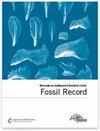The oldest teleosts (Teleosteomorpha): their early taxonomic, phenotypic, and ecological diversification during the Triassic
IF 2.1
4区 地球科学
Q3 Earth and Planetary Sciences
引用次数: 0
Abstract
As the fossil record reveals, neopterygians had a major diversification after the great mass extinction at the Permian-Triassic boundary, including the appearance of the major clade Teleosteomorpha. Detailed studies of new taxa (Pseudopholidoctenus germanicus, Barschichthys ruedersdorfensis, and Ruedersdorfia berlinensis) from the lower Anisian (middle Muschelkalk) of Germany and their comparisons with other Triassic relatives are presented, including new information concerning size, shape, and diet. Two families, Pholidophoridae and Marcopoloichthyidae, made a modest appearance during the Anisian of Europe and Asia almost simultaneously, with Pseudopholidoctenus (and the teleosteomorphs Barschichthys and Ruedersdorfia) from the Germanic Basin, being the oldest stem teleosts (244 Ma), followed shortly by Marcopoloichthys ani from Italy. The early teleostean diversification was fast—already in the late Ladinian three lineages were present: Prohalecitiidae (Europe), Pholidophoridae (Asia, Europe), and Marcopoloichthyidae (Asia, Europe), with ca. 20 species inhabiting the Tethys Ocean during the Middle–Late Triassic. Most Triassic teleosteomorphs were small, ca. 50 mm standard length, and a few as possibly miniature, with torpedo or oblong shapes, and suction feeders—probably a plankton based-diet. These first Triassic radiations were replaced during the early Sinemurian of marine ecosystems of Europe with two major groups: (a) non-monophyletic ‘pholidophoriforms’ and (b) proleptolepids and leptolepids, having an average size (ca. 100 mm SL) longer than Triassic forms, with oblong and fusiform shapes. A fast dispersion from the Tethys to the Paleo-Pacific followed, as demonstrated by the presence of small (ca. 50 mm SL) suction feeder proleptolepids in the early Sinemurian of Chile.最古老的脊椎动物(Teleosteomorpha):三叠纪早期的分类、表型和生态多样化
化石记录显示,在二叠纪-三叠纪交界处的大灭绝之后,新翅类经历了一次重大的多样化,其中包括主要支系Teleosteomorpha的出现。本文详细研究了德国下安息年(Muschelkalk中段)的新类群(Pseudopholidoctenus germanicus、Barschichthys ruedersdorfensis和Ruedersdorfia berlinensis),并将它们与其他三叠纪亲缘动物进行了比较,包括有关大小、形状和食性的新信息。两个科,即Pholidophoridae和Marcopoloichthyidae,几乎同时在欧洲和亚洲的安尼西纪适度出现,其中来自日耳曼盆地的Pseudopholidoctenus(以及腕足动物Barschichthys和Ruedersdorfia)是最古老的茎腕足动物(244 Ma),随后是来自意大利的Marcopoloichthys ani。早期长脚类动物的多样化速度很快,在拉迪南晚期已经出现了三个品系:在三叠纪中-晚期,特提斯洋中栖息着大约 20 个物种。大多数三叠纪的远脊椎动物体型较小,标准体长约为 50 毫米,少数可能是微型鱼类,体形呈鱼雷状或长圆形,以吸食--可能以浮游生物为食。在欧洲海洋生态系统的新元古代早期,这些最初的三叠纪辐射类被两大类所取代:(a)非单系的 "pholidophoriforms "和(b)proleptolepids 和 leptolepids,它们的平均体型(标准长度约 100 毫米)长于三叠纪形式,体型呈长圆形和纺锤形。随后,从特提斯到古太平洋的快速扩散,智利早新武里期出现的小型(约 50 毫米)吸食原虫就证明了这一点。
本文章由计算机程序翻译,如有差异,请以英文原文为准。
求助全文
约1分钟内获得全文
求助全文
来源期刊

Fossil Record
PALEONTOLOGY-
CiteScore
2.50
自引率
7.10%
发文量
18
审稿时长
>12 weeks
期刊介绍:
Fossil Record (FR) is the palaeontological journal of the Museum für Naturkunde Berlin. This journal was founded in 1998 under the name Mitteilungen aus dem Museum für Naturkunde Berlin, Geowissenschaftliche Reihe and appears with two issues each year. Fossil Record publishes original papers in all areas of palaeontology including the taxonomy and systematics of fossil organisms, biostratigraphy, palaeoecology, and evolution. All taxonomic groups are treated, including invertebrates, microfossils, plants, and vertebrates.
 求助内容:
求助内容: 应助结果提醒方式:
应助结果提醒方式:


